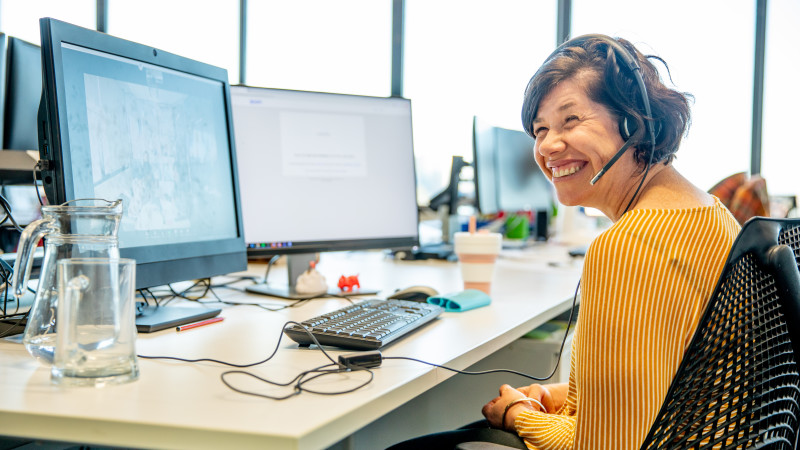Rachel DuRose, Madison Hoff, and Catherine Henderson | Feb 20, 2022, 7:30 AM
Josh Basile knows that people with disabilities make up a substantial pool of untapped talent. He has a law degree and serves as the community-relations manager for AccessiBe, a company trying to make websites more usable for people with different disabilities through artificial intelligence and an accessibility interface. He’s a C4-5 quadriplegic, so he knows firsthand what it takes to make a successful career with a disability.
“Employment is so important to make sure that persons with disabilities have a voice not only in the home but in the workplace and within their communities,” Basile told Insider. “Having a job is really important in today’s world to be able to have a purpose, to be able to have buying power, to be able to dictate what your life looks like.”
Bringing more Americans with disabilities into the workforce means companies must ensure that their workplaces, whether remote or in-person, are accessible and accommodating.
In the US, about 61 million adults — or about one in four — have a disability, according to the Centers for Disease Control and Prevention, and Basile said there’s plenty of room to improve their employment situation. Even before the pandemic, the unemployment rate for people with disabilities in the US was higher than the unemployment rate for people without disabilities.
The labor-force participation rate — the share of the population either working or actively looking for a job — for people with disabilities has also been lower than the rate for people without disabilities. That rate was 22.8% for Americans with disabilities in January, 44.4 percentage points lower than the 67.2% rate for Americans without disabilities.
“People with disabilities have to navigate a world that is still largely built for and reinforced by nondisabled individuals and norms,” Moeena Das, the chief operating officer of the National Organization on Disability, told Insider.
Das added that increasing the labor-force participation rate for people with disabilities starts with “really reinforcing and acknowledging that people with disabilities are as valuable of a talent pool as nondisabled.”
Small changes to the workplace can make a big difference
The first step in accommodating workers with disabilities is consulting with those workers, said Corey Anthony, the senior vice president and chief diversity development officer of AT&T. The company employs 7,000 workers with disabilities and uses a system, called iCount, to allow employees to self-identify their disability, Anthony said.
“We have an employee group that now has well over 3,500 members that focuses on issues that are unique to our employees with disabilities,” Anthony said. “We partner with them very closely — they are our eyes and ears about what is happening inside of our business with respect to this community.”
The accommodations that workers need may vary. Companies should listen and respect people’s knowledge of their own bodies and health.
The Employer Assistance and Resource Network on Disability Inclusion describes reasonable accommodations, or “adjustments or modifications that enable people with disabilities to perform the essential functions of a job efficiently and productively,” as “important retention and advancement tools.”
Tad Asbury, the executive director of Bridges From School to Work, a nonprofit connecting young adults with disabilities to meaningful work, provided an example of a simple but effective accommodation that JPMorgan made at one of its security facilities in Chicago after hearing from its employees.
The company required employees to use a locker to store personal belongings before entering the facility, but some new hires from the nonprofit struggled with the combination lockers. So JPMorgan switched the lockers to ones that used keys that were easier to handle.
“Recognize that accommodations can be inexpensive,” Asbury said. “It can be as simple as getting the lockers with a key instead of ones with combinations.”
Employers need to consider accommodations for workers with disabilities after the pandemic
While some people may be eager to return to offices, many workers with disabilities may prefer remote jobs and other flexible work situations that became more popular during the pandemic.
“When it comes to the experience of people with disabilities during the pandemic, it’s been a bit of a bittersweet experience,” Das said, because people with disabilities had been advocating flexible work models long before companies enacted such policies during the pandemic.
Companies have learned that they can continue operations with flexibility. Even when the pandemic ends, these work models can benefit people with disabilities, Das said.
She noted that not every worker is in a job that can be done remotely. For instance, according to the Bureau of Labor Statistics, 18% of workers with disabilities in 2020 were in service occupations, which include many in-person positions.
In addition to offering accommodations during recruiting, employers need to consider how inclusive their workplaces are for their existing staffers with disabilities. They can take an assessment like the National Organization on Disability’s Employment Tracker, a free and confidential assessment tool of six disability- and veterans’-inclusion focus areas like talent sourcing, to evaluate how they’re doing.
“So I’m deaf, for instance,” Das said. “Whether it’s myself, whether it might be somebody who has an auditory-processing disability, somebody who might have a cognitive disability, mask-wearing can be tremendously challenging. So what are some other adjustments that an employer may also need to make to your physical workspace as we’re really thinking about how we all move forward as a collective and make sure that our places are inclusive?”

